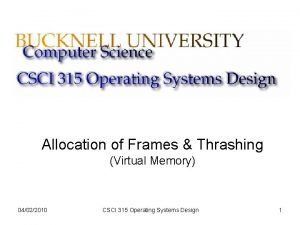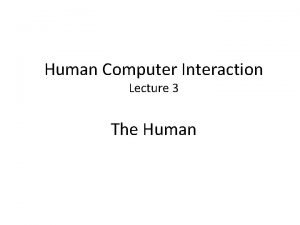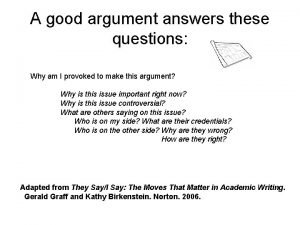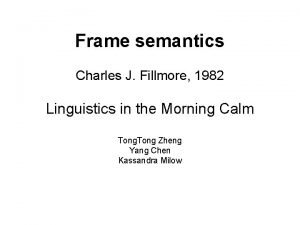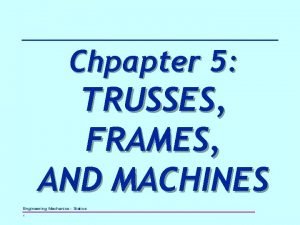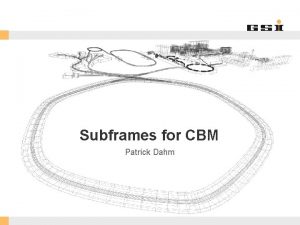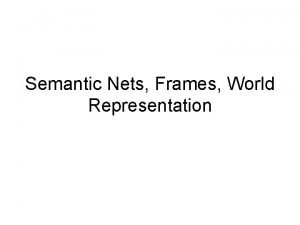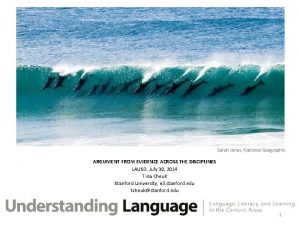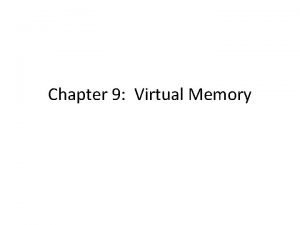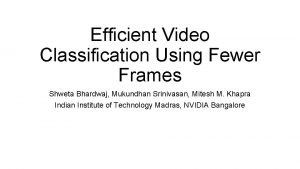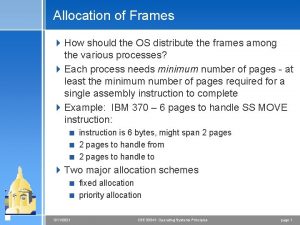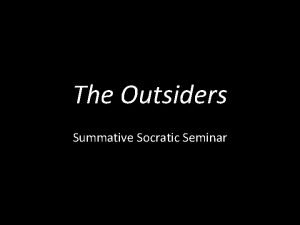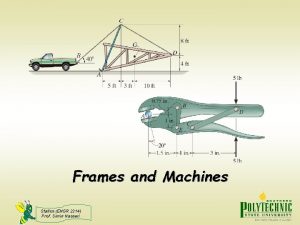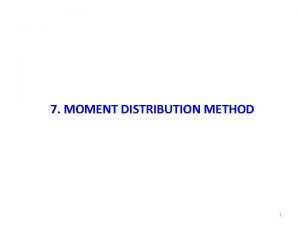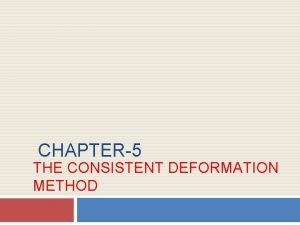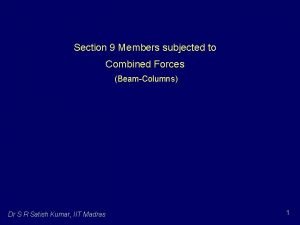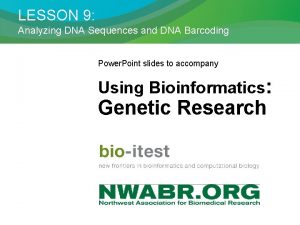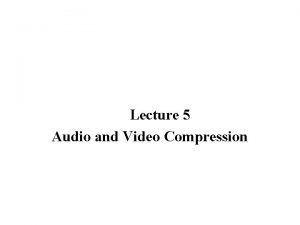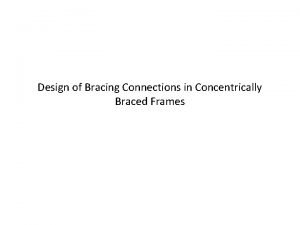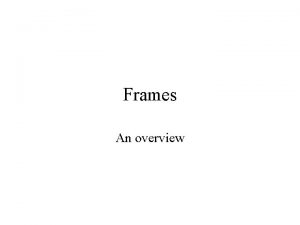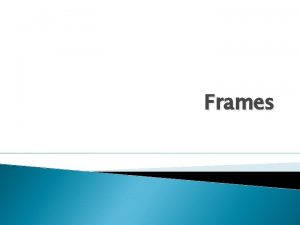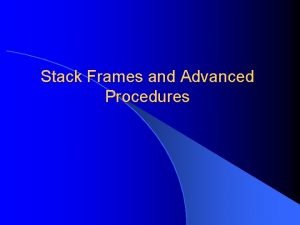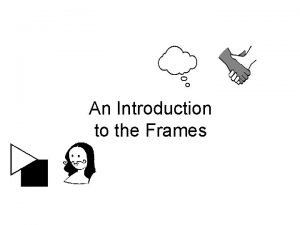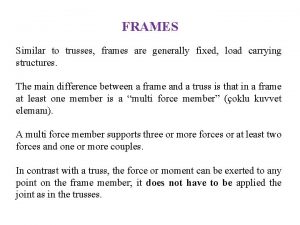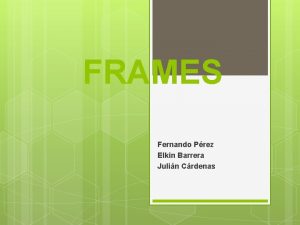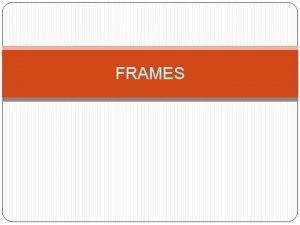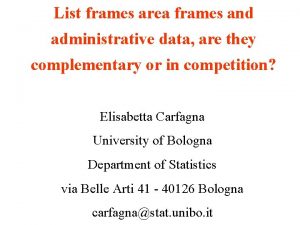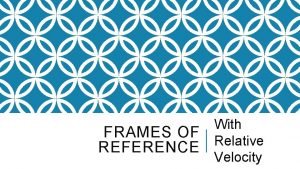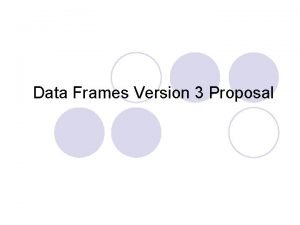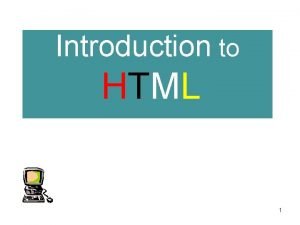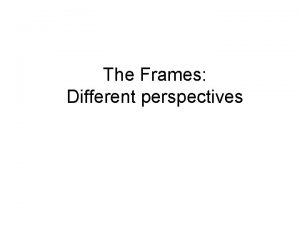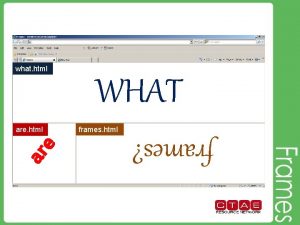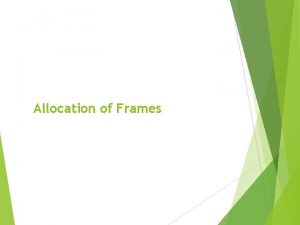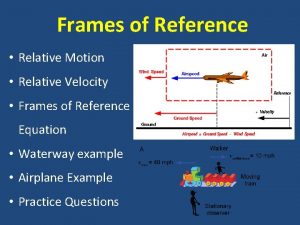Frames Geometry Angel 4 4 4 5 Angel



























![Mapping indices to faces • Form an array of face indices GLubyte cube. Indices[24] Mapping indices to faces • Form an array of face indices GLubyte cube. Indices[24]](https://slidetodoc.com/presentation_image_h2/dab072d01cf41b41439b12e42d10fd42/image-28.jpg)

- Slides: 29

Frames & Geometry Angel 4. 4 -4. 5 Angel: Interactive Computer Graphics 5 E © Addison-Wesley 2009 1

Objectives • Discuss frames • Introduce simple data structures for building polygonal models – Vertex lists – Edge lists • Open. GL vertex arrays Angel: Interactive Computer Graphics 5 E © Addison-Wesley 2009 2

Homogeneous Coordinates • The homogeneous coordinates form for a three dimensional point [x y z] is given as • p =[x’ y’ z’ w] T =[wx wy wz w] T • We return to a three dimensional point (for w 0) by x x’/w y y’/w z z’/w • If w=0, the representation is that of a vector • Note that homogeneous coordinates replaces points in three dimensions by lines through the origin in four dimensions • For w=1, the representation of a point is [x y z 1] Angel: Interactive Computer Graphics 5 E © Addison-Wesley 2009 3

Homogeneous Coordinates and Computer Graphics • Homogeneous coordinates are key to all computer graphics systems – All standard transformations (rotation, translation, scaling) can be implemented with matrix multiplications using 4 x 4 matrices – Hardware pipeline works with 4 dimensional representations – For orthographic viewing, we can maintain w=0 for vectors and w=1 for points – For perspective we need a perspective division Angel: Interactive Computer Graphics 5 E © Addison-Wesley 2009 4

Change of Coordinate Systems • Consider two representations of a the same vector with respect to two different bases. The representations are a=[a 1 a 2 a 3 ] b=[b 1 b 2 b 3] where v=a 1 v 1+ a 2 v 2 +a 3 v 3 = [a 1 a 2 a 3] [v 1 v 2 v 3] T =b u +b u = [b b b ] [u u u ] T 1 1 2 2 3 3 1 2 3 Angel: Interactive Computer Graphics 5 E © Addison-Wesley 2009 5

Representing second basis in terms of first • Each of the basis vectors, u 1, u 2, u 3, are vectors that can be represented in terms of the first basis u 1 = g 11 v 1+g 12 v 2+g 13 v 3 u 2 = g 21 v 1+g 22 v 2+g 23 v 3 u 3 = g 31 v 1+g 32 v 2+g 33 v 3 v Angel: Interactive Computer Graphics 5 E © Addison-Wesley 2009 6

Matrix Form • The coefficients define a 3 x 3 matrix M= • and the bases can be related by a=MTb • see text for numerical examples Angel: Interactive Computer Graphics 5 E © Addison-Wesley 2009 7

Change of Frames • We can apply a similar process in homogeneous coordinates to the representations of both points and vectors u 1 v 2 Consider two frames: Q 0 (P 0, v 1, v 2, v 3) (Q 0, u 1, u 2, u 3) P 0 v 1 v 3 Angel: Interactive Computer Graphics 5 E © Addison-Wesley 2009 u 2 u 3 8

Representing One Frame in Terms of the Other Extending what we did with change of bases u 1 = g 11 v 1 + g 12 v 2 + g 13 v 3 u 2 = g 21 v 1 + g 22 v 2 + g 23 v 3 u 3 = g 31 v 1 + g 32 v 2 + g 33 v 3 Q 0 = g 41 v 1 + g 42 v 2 + g 43 v 3 + g 44 P 0 defining a 4 x 4 matrix M= Angel: Interactive Computer Graphics 5 E © Addison-Wesley 2009 9

Working with Representations • Within the two frames any point or vector has a representation of the same form a=[a 1 a 2 a 3 a 4 ] in the first frame b=[b 1 b 2 b 3 b 4 ] in the second frame • where a 4 = b 4 = 1 for points and a 4 = b 4 = 0 for vectors and a=MTb • The matrix M is 4 x 4 and specifies an affine transformation in homogeneous coordinates Angel: Interactive Computer Graphics 5 E © Addison-Wesley 2009 10

Affine Transformations • Every linear transformation is equivalent to a change in frames • Every affine transformation preserves lines • However, an affine transformation has only 12 degrees of freedom because 4 of the elements in the matrix are fixed and are a subset of all possible 4 x 4 linear transformations Angel: Interactive Computer Graphics 5 E © Addison-Wesley 2009 11

The World and Camera Frames • When we work with representations, we work with n-tuples or arrays of scalars • Changes in frame are then defined by 4 x 4 matrices • In Open. GL, the base frame that we start with is the world frame • Eventually we represent entities in the camera frame by changing the world representation using the model-view matrix • Initially these frames are the same (M=I) Angel: Interactive Computer Graphics 5 E © Addison-Wesley 2009 12

Moving the Camera • If objects are on both sides of z=0, we must move camera frame M= Angel: Interactive Computer Graphics 5 E © Addison-Wesley 2009 13

GEOMETRIC MODELING Angel: Interactive Computer Graphics 5 E © Addison-Wesley 2009 14

Representing a Mesh • Consider a mesh e 2 v 6 e 1 v 1 e 6 v 5 e 3 e 8 v e 9 v 4 8 e 11 e 10 e 4 e 7 v 2 e 12 e 5 v 3 • There are 8 nodes and 12 edges – 5 interior polygons – 6 interior (shared) edges • Each vertex has a location vi = (xi yi zi) Angel: Interactive Computer Graphics 5 E © Addison-Wesley 2009 15

Simple Representation • Define each polygon by the geometric locations of its vertices • Leads to Open. GL code such as gl. Begin(GL_POLYGON); gl. Vertex 3 f(x 1, y 1, z 1); gl. Vertex 3 f(x 6, y 6, z 6); gl. Vertex 3 f(x 7, y 7, z 7); gl. End(); • Inefficient and unstructured – Consider moving a vertex to a new location – Must search for all occurrences Angel: Interactive Computer Graphics 5 E © Addison-Wesley 2009 16

Inward and Outward Facing Polygons • The order {v 1, v 6, v 7} and {v 6, v 7, v 1} are equivalent in that the same polygon will be rendered by Open. GL but the order {v 1, v 7, v 6} is different • The first two describe outwardly facing polygons • Use the right-hand rule = counter-clockwise encirclement of outward-pointing normal • Open. GL can treat inward and outward facing polygons differently Angel: Interactive Computer Graphics 5 E © Addison-Wesley 2009 17

Geometry vs Topology • Generally it is a good idea to look for data structures that separate the geometry from the topology – Geometry: locations of the vertices – Topology: organization of the vertices and edges – Example: a polygon is an ordered list of vertices with an edge connecting successive pairs of vertices and the last to the first – Topology holds even if geometry changes Angel: Interactive Computer Graphics 5 E © Addison-Wesley 2009 18

Vertex Lists • Put the geometry in an array • Use pointers from the vertices into this array • Introduce a polygon list P 1 P 2 P 3 P 4 P 5 topology v 1 v 7 v 6 v 8 v 5 v 6 x 1 y 1 z 1 x 2 y 2 z 2 x 3 y 3 z 3 x 4 y 4 z 4 x 5 y 5 z 5. x 6 y 6 z 6 x 7 y 7 z 7 geometry x 8 y 8 z 8 Angel: Interactive Computer Graphics 5 E © Addison-Wesley 2009 19

Shared Edges • Vertex lists will draw filled polygons correctly but if we draw the polygon by its edges, shared edges are drawn twice • Can store mesh by edge list Angel: Interactive Computer Graphics 5 E © Addison-Wesley 2009 20

Edge List e 2 e 1 e 2 e 3 e 4 e 5 e 6 e 7 e 8 e 9 v 1 v 6 x 1 y 1 z 1 x 2 y 2 z 2 x 3 y 3 z 3 x 4 y 4 z 4 x 5 y 5 z 5. x 6 y 6 z 6 x 7 y 7 z 7 x 8 y 8 z 8 v 6 e 1 v 1 e 6 v 5 e 3 e 8 v e 9 8 e 11 e 10 e 4 e 7 v 2 e 12 e 5 v 3 Note polygons are not represented Angel: Interactive Computer Graphics 5 E © Addison-Wesley 2009 21

Modeling a Cube Model a color cube for rotating cube program Define global arrays for vertices and colors GLfloat vertices[][3] = {{-1. 0, -1. 0}, {1. 0, -1. 0}, {-1. 0, 1. 0}, {1. 0, 1. 0}, {-1. 0, 1. 0}}; GLfloat colors[][3] = {{0. 0, 0. 0}, {1. 0, 0. 0}, {0. 0, 1. 0}, {1. 0, 1. 0}, {0. 0, 1. 0}}; Angel: Interactive Computer Graphics 5 E © Addison-Wesley 2009 22

Drawing a polygon from a list of indices • Draw a quadrilateral from a list of indices into the array vertices and use color corresponding to first index void polygon(int a, int b, int c , int d) { gl. Begin(GL_POLYGON); gl. Color 3 fv(colors[a]); gl. Vertex 3 fv(vertices[b]); gl. Vertex 3 fv(vertices[c]); gl. Vertex 3 fv(vertices[d]); gl. End(); } Angel: Interactive Computer Graphics 5 E © Addison-Wesley 2009 23

Draw cube from faces void colorcube( ) { polygon(0, 3, 2, 1); polygon(2, 3, 7, 6); polygon(0, 4, 7, 3); polygon(1, 2, 6, 5); polygon(4, 5, 6, 7); polygon(0, 1, 5, 4); } 5 6 2 1 7 4 0 3 Note that vertices are ordered so that we obtain correct outward facing normals Angel: Interactive Computer Graphics 5 E © Addison-Wesley 2009 24

Efficiency • The weakness of our approach is that we are building the model in the application and must do many function calls to draw the cube • Drawing a cube by its faces in the most straight forward way requires – 6 gl. Begin, 6 gl. End – 6 gl. Color – 24 gl. Vertex – More if we use texture and lighting Angel: Interactive Computer Graphics 5 E © Addison-Wesley 2009 25

Vertex Arrays • Open. GL provides a facility called vertex arrays that allows us to store array data in the implementation • Six types of arrays supported – – – Vertices Color indices Normals Texture coordinates Edge flags • We will need only colors and vertices Angel: Interactive Computer Graphics 5 E © Addison-Wesley 2009 26

Initialization • Using the same color and vertex data, first we enable gl. Enable. Client. State(GL_COLOR_ARRAY); gl. Enable. Client. State(GL_VERTEX_ARRAY); • Identify location of arrays gl. Vertex. Pointer(3, GL_FLOAT, 0, vertices); 3 d arrays stored as floats data array data contiguous gl. Color. Pointer(3, GL_FLOAT, 0, colors); Angel: Interactive Computer Graphics 5 E © Addison-Wesley 2009 27
![Mapping indices to faces Form an array of face indices GLubyte cube Indices24 Mapping indices to faces • Form an array of face indices GLubyte cube. Indices[24]](https://slidetodoc.com/presentation_image_h2/dab072d01cf41b41439b12e42d10fd42/image-28.jpg)
Mapping indices to faces • Form an array of face indices GLubyte cube. Indices[24] = {0, 3, 2, 1, 2, 3, 7, 6 0, 4, 7, 3, 1, 2, 6, 5, 4, 5, 6, 7, 0, 1, 5, 4}; • Each successive four indices describe a face of the cube • Draw through gl. Draw. Elements which replaces all gl. Vertex and gl. Color calls in the display callback Angel: Interactive Computer Graphics 5 E © Addison-Wesley 2009 28

Drawing the cube • Method 1: what to draw number of indices for(i=0; i<6; i++) gl. Draw. Elements(GL_POLYGON, 4, GL_UNSIGNED_BYTE, &cube. Indices[4*i]); format of index data start of index data • Method 2: gl. Draw. Elements(GL_QUADS, 24, GL_UNSIGNED_BYTE, cube. Indices); Draws cube with 1 function call!! Angel: Interactive Computer Graphics 5 E © Addison-Wesley 2009 29
 Molecular geometry of pf3
Molecular geometry of pf3 Electron domain geometry vs molecular geometry
Electron domain geometry vs molecular geometry The basis of the vsepr model of molecular bonding is
The basis of the vsepr model of molecular bonding is Allocation of frames
Allocation of frames Sue palmer skeleton books
Sue palmer skeleton books Information reproduced from memory can be assisted by cues.
Information reproduced from memory can be assisted by cues. Counter argument sentence frames
Counter argument sentence frames Sue palmer skeletons for writing
Sue palmer skeletons for writing Frame linguistica
Frame linguistica Frames engineering mechanics
Frames engineering mechanics Dahm frames
Dahm frames Semantic nets and frames
Semantic nets and frames Sentence frames for evidence
Sentence frames for evidence Slab is one or more physically contiguous frames.
Slab is one or more physically contiguous frames. Titch miller
Titch miller What is author's purpose? *
What is author's purpose? * Efficient video classification using fewer frames
Efficient video classification using fewer frames Allocation of frames in os
Allocation of frames in os Sentence starters for socratic seminar
Sentence starters for socratic seminar Machines statics
Machines statics Moment distribution method
Moment distribution method Consistent deformation method
Consistent deformation method 4 frames kindergarten
4 frames kindergarten 4 frames of organization
4 frames of organization Eccentrically braced frames
Eccentrically braced frames How many reading frames in dna
How many reading frames in dna Socratic
Socratic Effect audio
Effect audio The four frames of kindergarten
The four frames of kindergarten Hss bracing connections
Hss bracing connections



